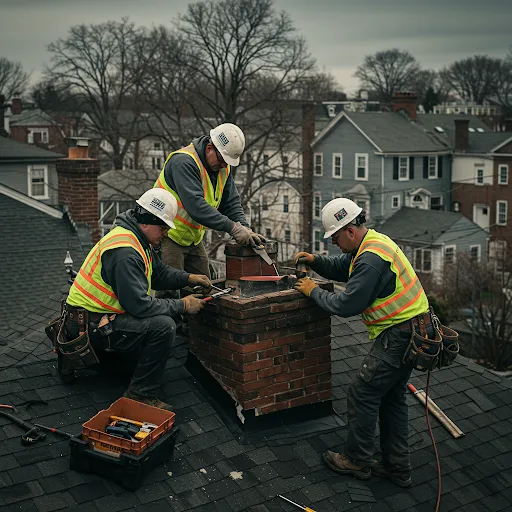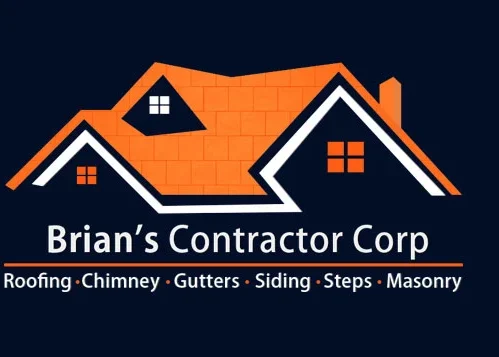
Has your ceiling near the fireplace developed water stains? Or have you noticed that the outside of your chimney has cracked bricks? These are not merely aesthetic problems; rather, they are indicators that your chimney may require urgent attention. For homeowners looking for solutions, our guide chimney repair Yonkers can help you understand and address these issues before they worsen.
Knowing chimney repair is important for Yonkers homeowners because it is not only about upkeep; it is about safeguarding your investment and your family.
As Yonkers chimney specialists, we are aware of the unique issues that local chimneys may face due to the weather in the Northeast. If left untreated, freezing winters, wet springs, and humid summers can hasten the decay of chimneys.
This guide will show you everything you need to know about chimney repair in Yonkers—from spotting warning signs to exploring repair options and finding the right experts for the job.
5 Warning Signs Your Home Needs Chimney Repair

Recognizing chimney problems early can save you thousands in repair costs and prevent dangerous situations. Here are the key indicators that your chimney requires professional attention.
Visible Damage – From Minor Cracks to Major Concerns
Chimney damage often starts small but can quickly escalate into serious structural issues. Regular visual inspections are your first line of defense.
On the outside of your chimney, check for spalling or fractured bricks. These issues are more than simply aesthetic; they are a sign that water has gotten inside the brickwork and is causing it to deteriorate from the inside out. Freeze-thaw cycles can hasten this deterioration in Yonkers, where many residences have old masonry.
Missing mortar between bricks, known as “mortar joints,” is another red flag. When mortar deteriorates, your chimney’s structural integrity is compromised, potentially leading to partial collapse during severe weather.
Water and Weather Damage – A Year-Round Threat
Water is your chimney’s worst enemy, and Yonkers’ climate presents particular challenges throughout the year.
Signs of water damage include:
- Rust stains on the exterior brickwork
- White staining (efflorescence) on chimney masonry
- Damp spots on walls or ceilings near the fireplace
- Musty odors when the fireplace isn’t in use
After a lot of rain or snowmelt, these symptoms frequently become more noticeable. Overnight, water seeping in, freezing, expanding, and further damaging the structure can cause minor fractures to become severe problems in Yonkers due to our winter freeze-thaw cycles.
Don’t wait for small issues to become emergencies. If you notice any signs of water intrusion, contact a chimney repair specialist immediately.
Smoking Issues – When Your Fireplace Fights Back
If smoke enters your home rather than exiting through the chimney, this indicates a significant problem that requires immediate attention.
Poor draft can be caused by blockages from debris, animal nests, or creosote buildup. It might also signal that your chimney height is insufficient relative to your roof line or nearby structures, creating downdrafts that push smoke back into your home.
Not only is this uncomfortable, but it’s also hazardous—smoke contains carbon monoxide and other harmful substances that should never circulate in your living space.
Creosote Buildup – The Silent Fire Hazard
Creosote is a highly flammable, tar-like substance that forms when wood smoke condenses inside your chimney. It appears as black or brown deposits ranging from flaky to glossy and tar-like.
If you notice thick, crusty layers inside your chimney or smell a strong, acrid odor when using your fireplace, excessive creosote may be present. This buildup is the leading cause of chimney fires and requires professional removal.
Annual chimney sweeping is essential in Yonkers homes that use fireplaces regularly during our cold winters to prevent dangerous levels of accumulation.
Damaged or Missing Chimney Cap – An Open Invitation to Problems
A chimney cap serves as your flue’s first line of defense against the elements and wildlife. Signs of a damaged or missing cap include:
- Animals or birds entering your chimney
- Excessive water entering during rainstorms
- Debris like leaves and twigs in your fireplace
- Rust forming on your damper or firebox
Without this protective covering, your chimney becomes vulnerable to water damage, animal infestations, and blockages that can lead to dangerous backdrafts or even carbon monoxide poisoning in your home.
Want to know the signs of chimney damage or learn more about how your chimney works? Explore our post: What Is a Chimney? Understanding Its Structure and Purpose.
Essential Chimney Repairs Every Homeowner Should Know

Understanding common chimney repairs helps you make informed decisions about maintenance and when to call professionals. Here are the most important repairs Yonkers homeowners should be familiar with.
From minor masonry faults to damage to the flue liner, chimney repairs can solve a variety of difficulties.
Restoration includes repairing cracks, replacing damaged bricks, cleaning the flue, ensuring adequate ventilation, and protecting the building from water damage.
You may be able to do little repairs on your own, but larger problems need expert assistance.
Protecting Your Investment – Crown and Flashing Repairs
Your chimney crown and flashing are your first line of defense against water damage.
The chimney crown sits at the top of your chimney, protecting the brick structure from water penetration. When crowns crack or deteriorate, water seeps directly into the chimney, causing extensive damage. Chimney crown repair ranges from simple sealant applications for minor cracks to complete crown rebuilds for severely damaged structures.
The metal barrier that separates your chimney from the roof is repaired by chimney flashing, which keeps water out at this crucial intersection. Flashing may separate from the roof or chimney in Yonkers, where there are frequent temperature swings, allowing water to enter.
Here’s a quick scenario: A Yonkers homeowner noticed water damage on their living room ceiling during heavy rains. During the inspection, they found that the chimney flashing had separated from the roof because of age and weather damage. A professional repaired the flashing and sealed the junction properly. The repair cost was minimal compared to the potential damage to interior ceilings and insulation had the issue been ignored.
Proper crown and flashing repairs typically include:
- Thorough inspection of existing damage
- Removal of deteriorated materials
- Application of proper waterproofing materials
- Installation of high-quality, durable components designed for Yonkers’ climate
Structural Integrity – Masonry and Liner Solutions
The masonry structure and interior liner of your chimney are critical to both safety and function.
Repointing—replacing deteriorated mortar between bricks—is among the most common repairs for Yonkers chimneys. This process strengthens the structure and prevents further water penetration. For older homes in Yonkers, proper repointing requires matching the original mortar composition for both structural integrity and historical accuracy.
Chimney liners protect your home from heat and combustion byproducts. When liners crack or deteriorate, they create serious fire and carbon monoxide hazards. Modern liners are usually made of stainless steel or cast-in-place materials, offering better protection and durability than old clay tile liners.
Chimney liners must be installed professionally for safety and compliance because Yonkers building rules have strict requirements for both new construction and modifications.
Professional vs DIY – Making the Right Choice for Your Chimney
Knowing when to fix a chimney yourself and when to call professionals can save you time, money, and keep you safe.
DIY maintenance can include:
- Visual inspections from ground level
- Keeping the chimney cap clear of debris
- Monitoring for early signs of damage
- Basic cleaning of accessible areas
However, most chimney repairs require professional expertise. Working at height on rooftops is inherently dangerous. Additionally, improper repairs can lead to water damage, structural issues, and even fire hazards.
Professional chimney technicians bring specialized equipment, extensive training, and proper safety gear. In Yonkers, where many homes have historic masonry chimneys, experienced professionals understand the specific challenges and appropriate materials needed for lasting repairs.
What seems like a simple fix may uncover bigger issues that only trained professionals can spot. Investing in professional chimney repair usually saves money by solving problems properly the first time.
Finding Trusted Chimney Repair Services in Yonkers
Selecting the right chimney repair professional is crucial for quality, safety, and value. Here’s how to find reliable chimney service in Yonkers.
Start by checking credentials. Trusted chimney professionals should be certified by the Chimney Safety Institute of America (CSIA) or the National Chimney Sweep Guild. These certifications ensure technicians understand proper inspection and repair procedures.
Ask these essential questions before hiring:
- How long have you been servicing chimneys in Yonkers?
- Can you provide local references from similar repair projects?
- Are you fully insured for both liability and workers’ compensation?
- What warranties do you offer on repairs?
- Do you perform a camera inspection as part of your assessment?
Here’s a scenario: A Yonkers family needed chimney restoration after noticing cracks in their chimney crown. They contacted three service providers.
- The first gave a very low estimate without inspecting the chimney.
- The second did a full inspection, including a camera check of the fuel, and provided a detailed report with photos of the issues.
- The third offered a high chimney repair cost without any explanation. By choosing the thorough middle option, they got well-documented repairs that fixed all the underlying problems, not just the surface issues.
Always get multiple estimates, but remember that the lowest price isn’t always the best value. Quality materials and proper techniques may cost more initially but provide longer-lasting protection.
Protecting Your Home and Family – Next Steps for Chimney Safety
Now that you understand what chimney repair is, it’s time to take action. Regular maintenance prevents costly emergency repairs and protects your family from potential hazards.
Schedule an annual professional chimney sweep, ideally before winter when your fireplace will see the most use. This step helps find small issues before they become big problems, ensuring your chimney works safely during the heating season.
Consider a water-repellent treatment for your chimney’s masonry. Applied by professionals, these treatments help the brick stay dry while allowing it to breathe, especially important in Yonkers’ climate.
Remember, your chimney is not just for decoration—it’s an important ventilation system that protects your home from fire hazards and toxic gases. Investing in proper repairs and maintenance ensures peace of mind and helps maintain your home’s value.
Contact us to speak with a certified chimney rebuild specialist and schedule an inspection, ensuring your chimney home stays safe and warm year-round.
CALL US AT 929-570-7620
Visit us on Google: https://g.co/kgs/AzqF3L5


